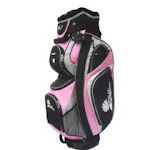The evolution of the hybrid is similar to that of snowboards: an offbeat, intriguing, even necessary idea with early shortcomings that eventually changed the sport. In 2004, the Darrell Survey Company polled golfers and found that fewer than 1 in 12 carried a hybrid club; but today 1 in 2 golfers carry a hybrid.
Although the first hybrids were admirable as a solution to hard-to-hit long irons, the latest versions have made fundamental advancements in playability. Designers are now able to create a large face and still save weight (about double that of five years ago), which can help position the center of gravity lower and deeper to optimize ball flight. Freeing weight leads to design ideas that couldn't be implemented previously. For example, the soles on early hybrids often were flat and ineffective, but today's leading edges and sole-bounce angles allow the clubs to move through the turf more easily. Another advancement is the ability to individually adjust head shape and size as lofts change. That makes high-lofted hybrids easier to maneuver and low-lofted ones more forgiving.
These improvements have made the hybrid golf's must-have club.
HOW MUCH LIFE IS LEFT?
There are grades of obsolescence. Our four judges, after consulting with members of our academic and retail panel to help determine what keeps a club relevant, assigned a level of "life remaining" to each club. None of the battery icons is completely full. Only current products might achieve that. Three-quarters full, and you're still OK. Half full means it's time to at least start looking. One-quarter full, and you'd better be buying. The red light on? Don't play with these again. Ever.
By Mike Stachura, Golf Digest April, 2010
Read More http://www.golfdigest.com/golf-equipment/2010-05/obsolete-list-hybrids#ixzz0mW5tE000
Showing posts with label golf hybrids. Show all posts
Showing posts with label golf hybrids. Show all posts
Thursday, April 29, 2010
Fairway Woods: When Are You Loyal to a Fault?
Fairway woods age gracefully. Their slip into obsolescence is quiet. While your eye is always wandering for a new big dog, the fairway wood is a loyal dog. To put it down can break your heart.
But the reality is, over time all dogs lose steps to the pack. Because clubhead crowns can be cast half as thick as they could a decade ago, modern fairway woods are bigger with lower centers of gravity that make it easier to launch the ball for distance (the 1998 Callaway Steelhead was 137 cubic centimeters; today's fairway woods are as big as 200cc). The deep-face woods of the past were effective as driving clubs off the tee, but when used from a tight fairway lie, the ball could balloon significantly, affecting distance. Although modern fairway woods have wider soles, they're made to look pleasing. Designers fiddle with crown curvature and other transitions to make woods play big while maintaining a compact look.
Unlike drivers, only a handful of fairway woods to date have achieved the USGA coefficient of restitution (springlike effect) limit of .83. As designers get better and better, count on a lot more clubs in this category becoming obsolete.
HOW MUCH LIFE IS LEFT?
There are grades of obsolescence. Our four judges, after consulting with members of our academic and retail panel to help determine what keeps a club relevant, assigned a level of "life remaining" to each club. None of the battery icons is completely full. Only current products might achieve that. Three-quarters full, and you're still OK. Half full means it's time to at least start looking. One-quarter full, and you'd better be buying. The red light on? Don't play with these again. Ever.
Article by Max Adler Golf Digest April, 2010
Read More http://www.golfdigest.com/golf-equipment/2010-05/obsolete-list-woods#ixzz0mW1nqUFq
But the reality is, over time all dogs lose steps to the pack. Because clubhead crowns can be cast half as thick as they could a decade ago, modern fairway woods are bigger with lower centers of gravity that make it easier to launch the ball for distance (the 1998 Callaway Steelhead was 137 cubic centimeters; today's fairway woods are as big as 200cc). The deep-face woods of the past were effective as driving clubs off the tee, but when used from a tight fairway lie, the ball could balloon significantly, affecting distance. Although modern fairway woods have wider soles, they're made to look pleasing. Designers fiddle with crown curvature and other transitions to make woods play big while maintaining a compact look.
Unlike drivers, only a handful of fairway woods to date have achieved the USGA coefficient of restitution (springlike effect) limit of .83. As designers get better and better, count on a lot more clubs in this category becoming obsolete.
HOW MUCH LIFE IS LEFT?
There are grades of obsolescence. Our four judges, after consulting with members of our academic and retail panel to help determine what keeps a club relevant, assigned a level of "life remaining" to each club. None of the battery icons is completely full. Only current products might achieve that. Three-quarters full, and you're still OK. Half full means it's time to at least start looking. One-quarter full, and you'd better be buying. The red light on? Don't play with these again. Ever.
Article by Max Adler Golf Digest April, 2010
Read More http://www.golfdigest.com/golf-equipment/2010-05/obsolete-list-woods#ixzz0mW1nqUFq
Subscribe to:
Posts (Atom)







